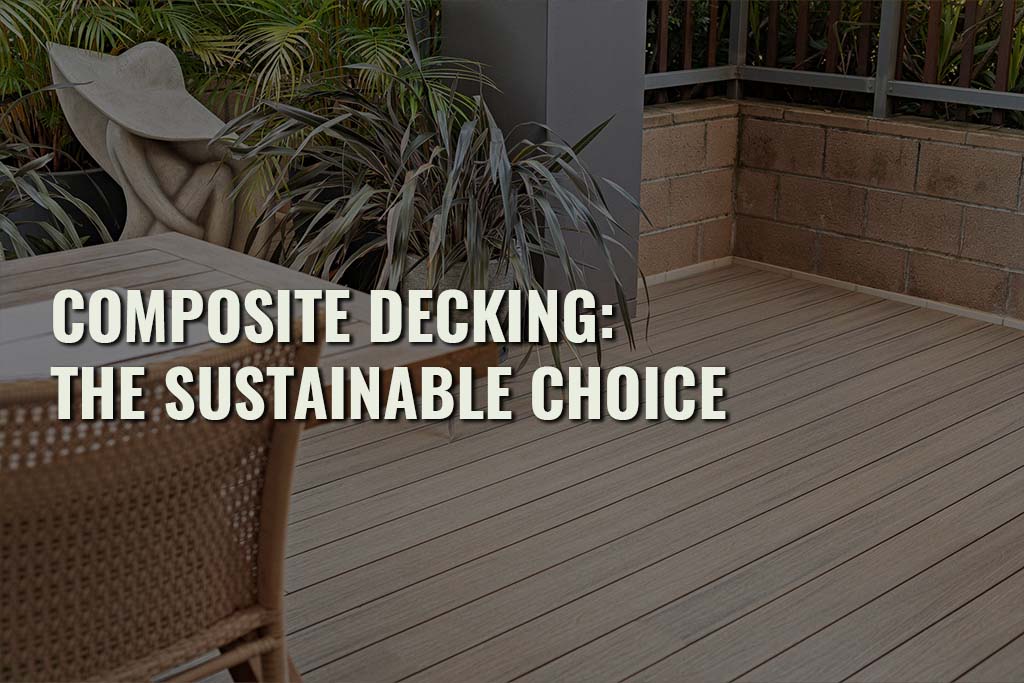Ever since solar panels became accessible, commonplace and spotted on the rooftops of most suburban estates, homeowners have been encouraged to consider the emissions and sustainability of their property. These days, it is simple to research the environmental impact of your lifestyle, and as a result, many are thinking about the products they use both inside and outside of their home.
More so, it is only natural that those who love outdoor living would care about the sustainability of their practices, doing all they can to ensure the environment they love so much won’t be impacted by their day-to-day life. These are just some of the reasons why composite decking has experienced a boom in popularity and accessibility over the past decade as more and more homeowners are making the switch to environmentally friendly choices.
What makes composite decking different?
Composite decking is one of the most sustainable and low impact options you can use to create a beautiful deck. Each lineal metre contains a combination of recycled plastic and wood. In combination, these two materials build a strong and durable foundation that ranks high in sustainability.
What makes a business sustainable?
Production practices, minimal environmental disruption, and low electrical operating costs are a few features to mention. A sustainable product also repurposes materials that were otherwise discarded by others. Here are some concrete examples of sustainable business practices:
-
Eco-friendly production practices
A business that cares about sustainability will ensure they are cutting down on energy costs wherever possible. For example, at the Brite Decking composite decking factory, a proportion of our production power is captured from solar energy. Using sustainable energy is hugely important to our company’s ethos. Additionally, Brite Decking installed a circulating, cooling water system to the factory, greatly reducing the amount of water used during product fabrication. As of 2022, the factory is ISO 14000 certified.
-
Forward thinking for future generations
Businesses must consider their environmental footprint in the years to come. With our impact on the future in mind, the Brite Decking factory will install more solar panels over the course of 2022. This will increase its percentage of renewable energy used for production.
-
Board Assembly and Upkeep
Composite decking is crafted with recycled plastics that would otherwise rot away in a landfill. The environmental friendliness doesn’t stop at the materials used but continues into the way composite decking is put together and cared for. Precise measuring during production allow us to eliminate material waste like the wood scraps that many timber decking companies are left with. When you install timber decking at your home or office, there is minimal upkeep with no need for hazardous or toxic substances to weatherproof the boards.
The truth about timber…
Timber decking is as old as time and is usually the first thing people think of when planning their backyard escape, however, timber is not all it’s cracked up to be. The environmental concerns around timber decking start right at the beginning of its lifecycle, with deforestation and habitat destruction becoming a greater issue with every chopped down tree. There are environmentally friendly and sustainably sourced timber sources, but the regulation around such products is not reliable. Native and tropical hardwoods are susceptible to damage from wood rot, termites, age, weather damage, even termites, and their upkeep requires harsh, potentially toxic sealants and cleaners.
As can be seen in our Urban Eco Range, composite decking achieves the natural and traditional look of timber decking without the added costs and environmental concerns. With anti-fade resistance, anti-slip technology and multiple colour choices, our urban eco decking does everything that traditional timber can’t, plus so much more.
An eco-choice from creation to completion…
Composite decking was created with sustainability in mind, so it’s integral that each board is made with the lowest emissions and lowest impact possible.
Sustainable Material Formation
The composition of composite boards depends mainly on the brand and type of board; however, most premium composite boards are made from a mixture of recycled plastics and reclaimed timber. The timber in the board will be from bamboo, sawdust, offcuts and wood waste that has come from other large-scale projects and surrendered for recycling. This process saves precious wood from being incinerated or left to rot and gives it a new life in decking.
The plastic in composite boards is incorporated from plastic that has otherwise used up its purpose such as milk bottles, plastic bags and other household single use plastics. Composite decking gives life to these items that can’t otherwise find new meaning, saving them from waterways and landfills. By decreasing the demand for new timber and plastic, composite decking is going a long way in lowering the rates of deforestation and destruction of habitats both within Australia and around the globe.
Development
Composite decking requires a high energy output to manufacture, however, premium products such as those in our Urban Eco Range use minimal water and energy during the process, producing little waste along the way. The process to treat timber and prepare it for daily use involves toxic chemicals. With composite decking, this isn’t necessary, as they are tailor made for pets, people and BBQ’s.
Upkeep
Anything worth having is worth caring for, and your decking is no exception; however, it doesn’t have to take up your entire Sunday. Timber decking requires regular oiling, painting, sealing and staining along with chemical treatments to fend off termites, rot and mould. Each of these treatments can be costly, time-consuming and toxic to the environment, and the result may not be as long-lasting as composite decking. Composite decking requires a simple wash, uses fewer chemicals overall, and is naturally resistant to pests, mould, rot and weather damage.
Lifespan
One of the biggest impacts on the environment is fast use and fast disposal with anything from cheap furniture to cheap clothing ending up in the landfill. Longevity of use is one of the most environmentally sustainable practices, and with composite decking lasting well into 3 decades, this is an assurance. You are less likely to need to replace your decking, which justifies the energy cost and materials needed to create the deck in the first place. Ultimately, you can rest easy knowing you aren’t contributing to toxic and overpopulated landfill with your decking choice.
A well-built deck can add value to your home, the lifestyle of your everyday and provide a space to relax unlike any other. Our customers use their composite decks more than they ever thought possible, enjoying the best of what the Australian outdoors has to offer. With premium composite decking, you can be assured that your choice is not only the best for your family, budget and lifestyle – but for the planet and future generations to come.
A Long-lasting Deck for Your Home…
Composite decking is long-lasting and low maintenance. It endures for up to 30 years with the right care, making it less likely to end up in landfills compared to its wooden or plastic decking counterparts.
You can rest assured that the planet and your family are kept safe with composite decking, requiring no injected chemicals or consistent sealing to remain free from rot or damage. Unlike pressure-treated wood that requires regular resealing and treatments to keep it looking fresh, composite decking simply requires a regular clean, even with the busiest most outdoor loving family.







